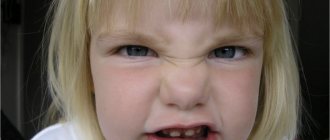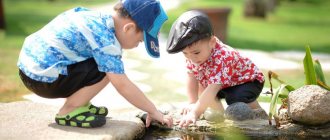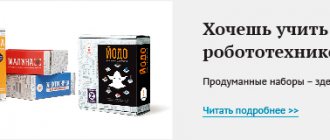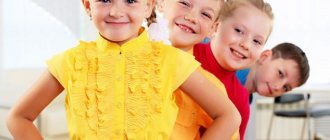At the present stage, preschool education plays a big role. Even more and more demands are placed on children of senior preschool age every year, especially in senior preschool age before directly entering school. Children must learn to comprehend educational information before they set foot in school.
Often, children of senior preschool age are prepared for school by instilling in them general and special knowledge, certain skills and certain skills. But they do not attach importance to the formation of their cognitive mental processes, and first of all, perception. But this is no less important. And maybe even the basis for successful schooling. After all, if a child of senior preschool age does not learn to perceive information, he will not be able to comprehend, process and evaluate it. The child will not master the school material and curriculum; his knowledge will not be formed.
Types and characteristics of perception in children of senior preschool age
Perception has the main types for learning at school:
- Visual - the child receives information through visual images. Information is processed visually, through the visual analyzing system.
- Auditory - information comes through the phonemic system of sounds, through rhythm and melody.
- Tactile - skin and motor sensations are involved here, and the hand must be in motion.
Some scientists assign perception the role of cognitive activity, as a result of which the child receives a certain type of information, realizes its features, explores and evaluates.
An important regulator of perception is the need to perceive the presented material.
A child’s ability to perceive information is not innate. It is necessary to develop children's perception. Different types of perception are developed by different means.
In older preschool age, perception develops in the form of visual sensations. 80% of all cognitive material that a child receives at this age is perceived through visual analyzers. This is mainly information about the world around us. At the end of the senior preschool age, the baby is no longer mistaken in distinguishing colors, even distinguishing between their shades.
Also, older preschoolers are characterized by high hearing sensitivity. The child distinguishes musical works, their rhythm and tempo.
Tactile sensitivity in older preschoolers develops through outdoor games, gymnastics and physical exercises.
When perceiving space, older preschoolers look for opportunities to explore different forms and try to compare objects. Children aged 5-7 years can navigate space and time quite well. They know when morning comes, when evening comes.
I would especially like to note the peculiarities in artistic perception in children. Children of senior preschool age, listening carefully to stories, try to influence literary characters. Expanding knowledge and ideas about reality contributes to the formation of artistic perception. This is also facilitated by the development of children's speech and thinking.
As for how young children perceive other people, it depends on the relationships established between them. Kids like people who have attractive qualities, adults and children, who easily make contact and communicate. If a child does not like someone, then he treats such a person with visible hostility. The reason may simply be a lack of interaction.
At 5 years old, a child’s perception is still involuntary; by the end of 6 years, children can set goals for studying and researching the properties of various objects, and can compare them.
In order for perception to develop successfully in children of senior preschool age, purposeful work is necessary.
Mechanism and types of perception
For the full development and effective learning of a child, a sufficient level of development of perception is necessary. It is the basis for the formation of other cognitive processes (memory, attention, thinking, speech and imagination). How does the process of perception occur?
- The world around us consists of various objects and phenomena that can be seen, heard, touched, tasted, smelled.
- With the help of our senses we learn about what an object is. For example, an orange has the following properties: round, orange, smooth, with small dimples on the peel, sour, and has a specific citrus smell.
- Information from the senses enters the brain, where individual sensations are combined into a holistic “picture” - perception.
- Perception is greatly influenced by accumulated life experience. If a child has already seen and eaten an orange, he does not need to taste it to guess what it is.
Classification of types of perception:
- Visual perception allows you to obtain a visual image of an object, as well as study its details;
- Auditory perception makes it possible to understand speech, recognize various sounds of nature, household noises and hear music;
- Tactile perception - cognition of objects through touch;
- Olfactory perception – recognition of odors;
- Taste perception – receiving information from taste buds (perception of sweet, salty, sour and bitter).
Most experts believe that each of us has a leading channel for receiving “data” about the world (usually vision, hearing or touch). Pay attention to the form in which your baby absorbs information better - this should be the main one in his learning.
Peculiarities of perception in children of senior preschool age
Auditory perception
Preschool auditory learners need to be given information in the form of audio recordings. You can sing individual sounds, syllables, and listen to CDs with educational texts.
A child’s auditory perception develops well on street walks; it is useful to invite children to listen to sounds, identify the noises and signals of cars, airplane noise, etc. You can ask to distinguish noises with your eyes closed. For example, you can determine whether a car is moving or standing still. Is the car far away or close?
Visual perception
Visual children need to be given more visual information, pictures, and illustrations. While learning to read, you can draw letters, act out scenes with fairy tale characters, and show videos.
Since vision in visual children is the main means of perceiving information, special exercises should be selected for this.
Selecting teaching materials, various mosaics and construction sets is an important way to convey educational information to children. Exercises for the development of visual perception include such as “Fold the pattern”, Dienesh blocks and others. If you use mosaics or puzzles, the parts must be of the optimal size.
Visual gymnastics is a must. It is carried out 3 times a day. The duration of visual exercises is 3-5 minutes. The exercises need to be varied, they must be in a playful form, so that children are emotionally pleased to perform such exercises. Visual games and exercises help improve blood circulation and correct visual processes. You can also use special simulators for this.
Child's tactile perception
A kinesthetic child should draw or, better yet, sculpt letters from plasticine.
To develop a child's tactile perception, you can invite him to explore various natural materials or different objects with a different structure. As a rule, children are good at distinguishing objects by touch by shape and size.
Children of senior preschool age enjoy playing with foil. With their eyes closed, they must first crumple the foil, roll it into a ball, then smooth the foil.
A very interesting exercise is to determine what is inside the ball. Each ball contains various substances - water, flour, sand, peas, various cereals (semolina, rice, buckwheat). Children are asked to find paired balls containing the same substances by touch.
Types of perception in preschoolers based on perceptual systems
The main types of perception in preschoolers develop on the basis of various analyzers:
- visual, which allows you to visually evaluate all the properties of an object;
- auditory, which helps to learn speech, recognize one’s native language, feel the sounds of nature, hear music;
- tactile, providing knowledge of an object through touch.
Auditory
With the help of hearing, the child learns to recognize the sounds of his native language, words and syllables. If in infancy the perception of speech is based on the rhythmic and melodic structure of words and sentences, then already at 1 year the formation of phonemic hearing begins. The baby needs another year for the acceptance of all the sounds of his native language to take shape and for the formation of a sound culture of speech to begin.
The development of auditory perception is most effective during walks, when the baby listens to the noise of the street, birdsong, the sound of rain, and steps. An excellent exercise is to close your eyes and try to understand from which side the bird is singing, or whether a car is driving far or close.
Visual
Visual perception is leading in preschool age in relation to other species. The ability to read, see the beauty of the world, and assess danger depends on it. Its leading role is justified by the fact that vision allows you to capture the entire object as a whole, as well as see details.
Visual signals arrive before the preschooler touches or tastes an object. In addition, examining an object is much safer than other methods of research.
Only at an early age, when the baby begins to comprehend the surrounding reality, his “eyes” are his hands. But at this stage, parents make sure that the child is in a protected space and that only safe objects are in his hands.
According to statistics, the number of visual people (who prefer visual perception) prevails in the world, so the development of this type requires special attention. The task of an adult in preschool age is to sharpen the child’s visual perception, and also to help him expand the range of perceived details.
With preschoolers you need to draw more, study pictures and illustrations. It is these children who enthusiastically engage in appliqué, putting together puzzles and mosaics, continuing to develop their visual senses. Drawing with children 3-4 years old can include both the traditional use of pencils and paints, and original techniques.
Tactile
Tactile or kinesthetic perception is directly related to touch. Younger preschoolers still trust their hands even more when familiarizing themselves with a new subject. That’s why they so insistently ask to give them something that interests them.
More details: How to develop tactile perception in preschool age.
Playing with materials of different structures, modeling, natural substances is a great way to develop the sense of touch. With their eyes closed, children enjoy rolling the foil into balls and smoothing it out. Great joy comes from the exercise of identifying bulk material in a cup. The eyes, of course, must also be blindfolded.
Features of methods for the formation of perception in preschool age
Based on the nature of perception of educational material, one can turn to visual, practical, game and verbal methods of their formation.
With visual methods, older preschoolers develop the ability to observe visual aids and examine samples of presented educational material.
Practical methods include exercises, experiments and experiments, various studies and modeling.
The main attention is now paid to verbal methods. These are stories from the teacher, children, literature is read to them, conversations with children. This is perhaps one of the main methods in preparing for school.
But the leading activity in preschool age is play. And it is she who should be at the head of the formation of all cognitive mental processes. The child’s perception is most effectively formed during didactic games, when playful and imaginary situations are created and roles are played out.
Ways to develop the perception of preschoolers
In preschool age, the leading activity is play. It is in this form that children learn and develop the necessary functions in the best way.
Didactics presents many games for the development of perception that will help parents or educators engage with their children.
- Droplets – teach how to combine objects based on color criteria. The essence of the task is that you need to put circles of the corresponding shades into containers.
- Umbrellas - form an understanding of the shape and color of objects. To play you need 4 umbrellas of primary colors and cardboard geometric shapes. The teacher reports that it is raining, it is urgent to hide the circles and triangles under umbrellas of different colors.
- Bag of secrets - allows you to identify an object based on tactile sensations. An opaque bag is filled with small toys. The child, without looking, must describe what came into his hand.
Similar games are played to develop the ability to recognize an object or item by smell or sound.
Regular classes to develop perception in preschoolers will ensure further effective cognitive advancement and the formation of a holistic, moral personality. Such a person will most likely have unconventional thinking and a high level of creativity.
How do children of middle preschool age (4-5 years old) perceive the world?
By the age of 5, children achieve significant success in their ability to perceive various parameters of the world around them:
- There are 7 or more colors;
- Have an idea of light and dark tones, “warm” and “cold” shades;
- Know the basic geometric shapes (circle, square, triangle, rectangle);
- Can compare objects by size (large, smaller, small);
- They begin to form the concept of time (today, yesterday, tomorrow, minutes, hours, days, weeks), but they are not yet able to apply knowledge about these abstract concepts into the life of a four-year-old;
- The perception of other people depends on their popularity in society and their relationship with the baby. Mom will always be perceived by the baby as the kindest and most beautiful.
How to write a term paper on speech therapy
07.09.2010 240021
These guidelines are compiled to help students gain an understanding of the content and structure of coursework in speech therapy.
Logopedia of pedagogical science that studies anomalies of speech development with normal hearing, explores the manifestations, nature and mechanisms of speech disorders, develops the scientific basis for overcoming and preventing them means of special training and education.
The subject of speech therapy as a science is speech disorders and the process of training and education of persons with speech disorders.
The object of study is a person suffering from a speech disorder.
The main task of speech therapy as a science is the study, prevention and elimination of various types of speech disorders.
Coursework in speech therapy is a student's scientific and experimental research. This type of educational activity, provided for by the educational and professional program and curriculum, contributes to the acquisition of skills in working with literature, analyzing and summarizing literary sources in order to determine the range of insufficiently studied problems, determining the content and methods of experimental research, processing skills and qualitative analysis of the results obtained. The need to complete coursework in speech therapy is due to the updating of knowledge concerning the content, organization, principles, methods and techniques of speech therapy work.
As a rule, during their studies, students must write two term papers - theoretical and practical.
The first course work should be devoted to the analysis and synthesis of general and specialized literature on the chosen topic. Based on this analysis, it is necessary to justify and develop a method of ascertaining (diagnostic) experiment.
In the second course work, it is necessary to provide an analysis of the results obtained during the ascertaining experiment, as well as determine the directions and content of speech therapy work, and select adequate methods and techniques of correction.
So, let’s present the general requirements for the content and design of coursework in speech therapy.
The initial and most important stage of working on a course project is the choice of a topic, which is either proposed by the supervisor or chosen by the student independently from a list of topics that are consistent with the areas of scientific research of the department.
Each topic can be modified, considered in different aspects, but taking into account a theoretical and practical approach. Having chosen a topic, the student needs to think through in detail its specific content, areas of work, practical material, etc., which should be reflected both in the formulation of the topic and in the further construction of the study. It should be recalled that the chosen topic may not only have a purely theoretical orientation, for example: “Dysarthria. Characteristics of the defect”, “Classification of dysgraphia”, but also take into account the practical significance of the problem under consideration, for example: “Speech therapy work on speech correction for dysarthria”. It should also be taken into account that when formulating a topic, excessive detail should be avoided, for example: “Formation of prosodic components of speech in preschoolers of the sixth year of life attending a preschool institution for children with severe speech impairments.”
The course work includes such mandatory parts as: introduction, three chapters, conclusion, bibliography and appendix.
The text of the term paper begins with the title page . An example of its design can be seen here.
Then the content of the work is given, in which the names of chapters, paragraphs, and sections are formulated in strict accordance with the content of the thesis. An example of its design can be seen here.
In the text, each subsequent chapter and paragraph begins on a new page. At the end of each chapter, the materials are summarized and conclusions are formulated.
The introduction reveals the relevance of the problem under consideration in general and the topic being studied in particular; the problem, subject, object, and purpose of the study are defined. In accordance with the goal and hypothesis, objectives and a set of research methods aimed at achieving the objectives must be defined.
The relevance of the topic lies in reflecting the current level of pedagogical science and practice, meeting the requirements of novelty and usefulness.
When defining the research problem, it is important to indicate what practical tasks it will help to implement in training and educating people with speech pathology.
The object of research is understood as certain aspects of pedagogical reality, perceived through a system of theoretical and practical knowledge. The ultimate goal of any research is to improve this object.
The subject of research is some part, property, element of an object, i.e. the subject of research always indicates a specific aspect of the object that is to be studied and about which the researcher wants to gain new knowledge. An object is a part of an object.
You can give an example of the formulation of the object, subject and problem of research:
– The object of the study is the speech activity of preschool children with phonetic-phonemic speech disorders.
– The subject of the study is the features of intonation speech of children with phonetic-phonemic speech disorders.
– The research problem is to determine effective directions for speech therapy work on the formation of intonation expressiveness of speech in the system of correctional intervention.
The purpose of the study contributes to the specification of the object being studied. The goal of any research is to solve a specific problem. The goal is specified in tasks taking into account the subject of research.
The research objectives are formulated in a certain sequence, which determines the logic of the research. The research objectives are set on the basis of a theoretical analysis of the problem and an assessment of the state of its solution in practice.
The first chapter is an analysis of literary sources, which examines the state of this problem in historical and modern aspects, and presents the most important theoretical principles that formed the basis of the study.
When writing the first chapter, you should pay attention to the fact that the text of the course work must be written in a scientific style. When presenting scientific material, it is necessary to comply with the following requirements:
– Specificity – a review of only those sources that are necessary to disclose only a given topic or solve only a given problem;
– Clarity – which is characterized by semantic coherence and integrity of individual parts of the text;
– Logicality – which provides for a certain structure of presentation of the material;
– Reasoning – evidence of thoughts (why this and not otherwise);
– Precision of wording, excluding ambiguous interpretation of the authors’ statements.
A literary review of the state of the problem being studied should not be reduced to a consistent presentation of literary sources. It should present a generalized description of the literature: highlight the main directions (currents, concepts, points of view), analyze in detail and evaluate the most fundamental works of representatives of these directions.
When writing a work, the student must correctly use literary materials, make references to the authors and sources from which the results of scientific research are borrowed. Failure to provide required references will reduce your coursework grade.
As a rule, in coursework on speech therapy, references to literary sources are formatted as follows: the number of the cited source in the general list of references is placed in square brackets. For example: General speech underdevelopment is a speech pathology in which there is a persistent lag in the formation of all components of the language system: phonetics, vocabulary and grammar [17].
When using quotations, in square brackets, in addition to indicating the source number, the page number from which this excerpt is taken is indicated, for example: Speech rhythm is based on a physiological and intellectual basis, since, firstly, it is directly related to the rhythm of breathing. Secondly, being an element that performs a communicative function, “correlates with meaning, i.e. controlled intellectually” [23, P.40].
However, course work should not be of a purely abstract nature, so you should not abuse the unreasonable abundance of citations. Quoting should be logically justified, convincing and used only when really necessary.
In the second chapter , devoted to experimental research, the organization should be described and the program of the ascertaining experiment should be presented. The survey methodology, as a rule, consists of a description of several series of tasks, with detailed instructions, visual and lexical material, the procedure for completing tasks by experiment participants, and scoring criteria. This chapter also provides a qualitative and quantitative analysis of the results obtained.
When analyzing the results of an experiment, it is necessary to use a scoring system. Examples of various criteria for quantitative and qualitative assessment are presented in the following works:
– Glukhov V.P. Formation of coherent speech in preschool children with general speech underdevelopment. - M.: Arkti, 2002. - 144 p.
– Fotekova T.A. Test methodology for diagnosing oral speech of primary schoolchildren. - M.: Arkti, 2000. - 56 p.
– Levchenko I.Yu. Pathopsychology: Theory and practice. - M.: Academy, 2000. - 232 p.
In order to visually present the results obtained during the experimental study, it is recommended to use tables, graphs, diagrams, etc. Histograms can be used in a variety of ways - columnar, cylindrical, planar, volumetric, etc. An example of the design of tables, figures, and histograms can be found here.
The third chapter provides a rationale for the proposed methods and techniques and reveals the content of the main stages of correctional work.
The conclusion contains a summary of the material presented and the main conclusions formulated by the author.
The bibliography must contain at least 25 sources. The list includes bibliographic information about the sources used in preparing the work. An example of its design can be seen here.
In the application you can present bulky tables or illustrations, examination protocols, observation records, products of activity (drawings, written works of children), notes from speech therapy classes, etc.
The volume of one course work must be at least 30 pages of typewritten text.
In general, coursework in speech therapy is the basis for a future thesis, in which the study of the begun problem can be continued, but from the standpoint of a different approach or a comparative analysis of the disorders being studied in different age categories of people with different types of speech disorders.
The content and format of theses in speech therapy can be found here.
Literature:
1. How to write a term paper on speech therapy: Methodological recommendations. Educational and methodological manual / Comp. Artemova E.E., Tishina L.A. / Ed. Orlova O.S. – M.: MGOPU, 2008. – 35 p.
2. Research work of students in the system of higher professional pedagogical education (specialty 031800 - Speech therapy). Methodological recommendations for completing the thesis / Compiled by. L.V. Lopatina, V.I. Lipakova, G.G. Golubeva. - St. Petersburg: Publishing house of the Russian State Pedagogical University named after. A. I. Herzen, 2002. - 140 p.





